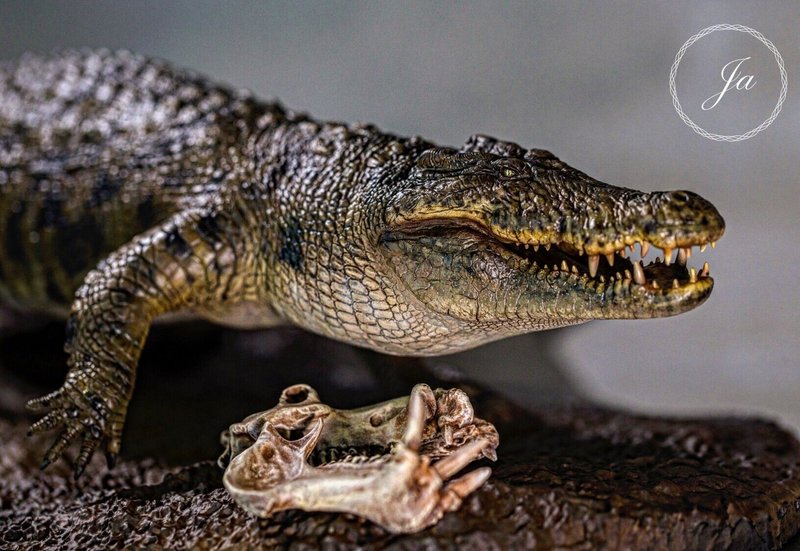
As we explore how the Nile crocodile appears in culture and folklore, we’ll look at various aspects, including mythology, art, and human perceptions. You might be wondering why these creatures have been so significant. It’s a blend of their impressive physical presence and the roles they’ve played in the lives of those who share their habitat. Let’s dive deeper into the fascinating world of the Nile crocodile!
Nile Crocodiles in Ancient Egyptian Mythology
In ancient Egypt, the Nile crocodile was more than just a fearsome predator; it was revered as a divine being. The Egyptian god Sobek, often depicted with a crocodile’s head, was associated with the Nile and represented fertility, protection, and military prowess. Sobek was believed to be a guardian of the pharaohs, which shows just how much significance the Nile crocodile held in ancient belief systems.
The stories of Sobek reveal how these reptiles were viewed as powerful protectors. People believed that by honoring Sobek, they could ensure safe travels along the Nile waters. Temples were built in his honor, where offerings were made, and rituals were performed. It’s fascinating to think about how these beliefs shaped the relationship between humans and these remarkable creatures.
Additionally, the crocodile’s ability to thrive in both water and land made it a symbol of adaptability and resilience. In a world where survival was paramount, the Nile crocodile embodied strength and tenacity—qualities that were deeply admired and respected.
Crocodiles in Folktales and Legends
Nile crocodiles often find their way into folktales and legends, serving as both villains and heroes. One popular tale features the transformation of a young girl into a crocodile to escape danger. This story highlights the dual nature of crocodiles as both protectors and fearsome creatures. In many cultures, they are seen as guardians of the water, reminding people of the delicate balance within the ecosystem.
Interestingly, these tales often carry moral lessons. For instance, they may teach about respecting nature and understanding the consequences of one’s actions. It’s as if the crocodile acts as a mediator between humans and the mysteries of the natural world, reminding us that our choices have profound effects.
In regions along the Nile, local storytellers have passed down these legends through oral traditions. They immerse listeners into a world where the Nile crocodile is not just an animal but a central character in the human experience. Just imagine sitting around a fire, listening to these tales as the night deepens—the croaking of frogs and the gentle ripple of the water creating a perfect backdrop.
Art and Symbolism of the Nile Crocodile
When it comes to art, the Nile crocodile has inspired countless representations, from ancient artifacts to modern interpretations. In Egyptian hieroglyphics, crocodiles symbolize power and aggression. They were often carved into stone, reminding viewers of their fierce nature and supernatural qualities. Statues depicting Sobek or crocodiles were commonly found in temples, emphasizing their importance in daily life and spirituality.
In contemporary art, the crocodile remains a popular subject. Artists use the reptile as a symbol of endurance and survival in their works. You might see crocodiles depicted in paintings or sculptures, showcasing their elegance and raw power. These artistic interpretations allow for a deeper appreciation of the Nile crocodile’s role not only in history but also in today’s society.
Moreover, the reptile’s adaptability has become a metaphor in various forms of art—representing resilience in the face of challenges. Artists often reflect on the concept of thriving amid adversity, drawing inspiration from the Nile crocodile’s ability to navigate two worlds—water and land.
The Nile Crocodile in Modern Culture
In modern culture, the Nile crocodile continues to captivate our imagination. Documentaries, wildlife shows, and films often feature this creature, showcasing both its beauty and ferocity. People are drawn to the thrill of watching these reptiles in their natural habitats—an experience that can be both exhilarating and sobering.
Conservation efforts have also highlighted the significance of the Nile crocodile in maintaining the ecosystem. Their role as apex predators keeps the populations of other species in check, promoting biodiversity. This growing awareness has brought the crocodile into environmental discussions, positioning it as a symbol of the need for conservation.
Interestingly, some cultures have adopted the crocodile in modern mythology too. You might hear stories of brave souls stepping up to protect the creature, showcasing a shift in how we perceive these animals. They are no longer just fearsome predators but are recognized as important contributors to our planet’s health.
Crocodiles as Cultural Icons in Contemporary Media
In contemporary media, the Nile crocodile often emerges as a cultural icon. From children’s cartoons to video games, it’s depicted in various ways, influencing public perception and understanding. For example, in many animated series, crocodiles are portrayed with exaggerated traits, often as humorous side characters or fierce adversaries. This portrayal shapes how younger generations view these reptiles—both intimidating yet fascinating.
Social media has also played a role in promoting the Nile crocodile. Viral videos showcasing their unique behaviors—like basking in the sun or quick strikes at prey—fascinate millions. These clips can inspire conservation discussions, urging people to respect and protect these amazing animals. The crocodile becomes a bridge connecting people with important environmental messages.
Moreover, merchandise featuring the Nile crocodile, such as clothing or toys, reflects its status as an enduring cultural figure. This sustained interest in the crocodile signifies its lasting impact on human culture and our collective consciousness.
The Role of Crocodiles in Folklore Around the World
While the Nile crocodile holds a particularly significant place in African and Egyptian culture, other cultures also have their own takes on crocodilians. For instance, in Indigenous Australian cultures, saltwater crocodiles are central figures in Dreamtime stories, symbolizing power and respect. Each culture tells its own unique narrative about these reptiles, often reflecting the relationship between the people and their environment.
In Asian cultures, such as those in India, crocodiles appear in various folk tales, often symbolizing danger or transformation. These stories usually serve as warnings about the unpredictability of nature, reminding listeners to stay vigilant and aware. It’s interesting how different regions use the crocodile in their folklore, yet often arrive at similar themes of respect and caution.
This global perspective on the crocodile enriches our understanding of its significance. It reveals how these creatures resonate differently across cultures while also uniting us in common themes of fear, respect, and admiration.
The Nile crocodile is much more than just a reptile lurking in the waters of the Nile. Its representation in culture and folklore is a testament to how deeply intertwined our lives are with nature. From ancient Egyptian mythology to modern media, this magnificent creature continues to inspire awe, respect, and creative expression.
The stories and symbols surrounding the Nile crocodile remind us of the powerful relationship between humans and the natural world. By appreciating these narratives, we can foster a better understanding of the importance of conservation and respecting wildlife. So next time you think of a Nile crocodile, remember that it’s not just an animal—it’s a cultural icon, a symbol of strength, and a reminder of the beauty and fragility of our ecosystems.

